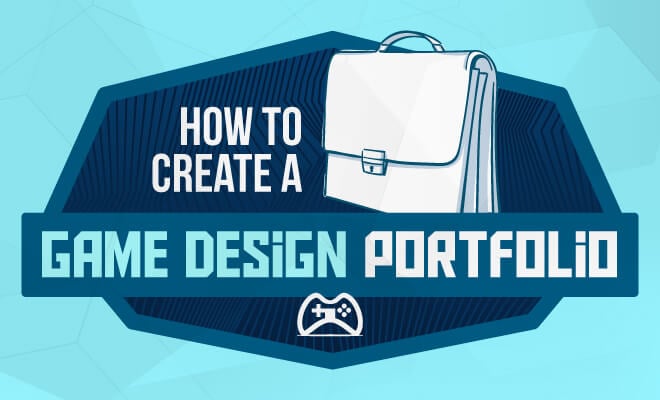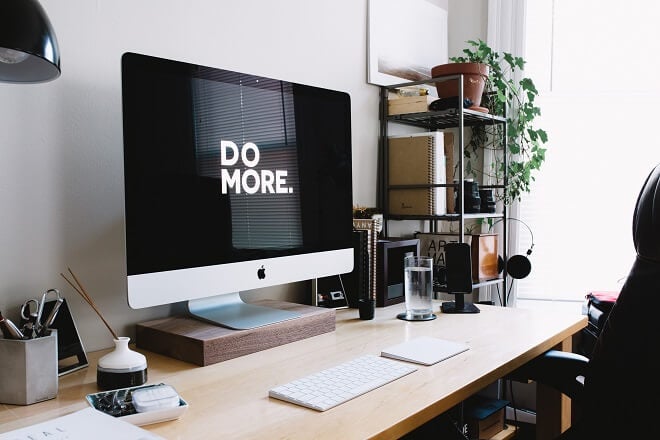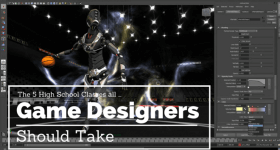 We are reader-supported. Purchases made through links on our site may earn us a commission. Learn More.
We are reader-supported. Purchases made through links on our site may earn us a commission. Learn More.
If you’ve ever asked a professor or game developer what steps you should take to get hired by a game company, chances are they’ve mentioned a game design portfolio at some point.
Since making games is a costly and challenging endeavor, game studios are very careful about who they hire to join their teams.
In other words, they want to see more than a diploma or certificate.
Once you’ve decided to put the time and effort into making your own portfolio, then comes the hard part: actually building it.
If you’re confused about what goes into a good game design portfolio or where to start, you’re not alone.
Keep reading to see all the advice and information you’ll need to get started on building a great design portfolio for yourself.
Do You Need a Game Design Portfolio?
If you want to significantly increase your chances of obtaining a job at a good game studio, then yes!
A portfolio is the easiest and most effective way for you to show off the relevant work that you’ve done. The fact that most designers have their own portfolio somewhere on the web would mean that you’ve put yourself at a disadvantage by not making one yourself.
With many other careers all you need is a good cover letter and solid resume to be considered for hire.
However, game companies want to hire designers who can confidently show that they’ve actually done what they’ll be expected to do if brought on board— make games.
It also gives you a chance to catch the attention of hiring managers and recruiters who have to sift through tons of applications and portfolios.
By making yours attractive and informative, you’re more likely to be remembered and thus called in for an interview.
How a Portfolio Will Benefit Your Career

If you’re still a college student or recently graduated and looking to break into the industry, a game design portfolio will help you immensely.
The truth is, most game studios want to hire people with professional experience, but that doesn’t mean they’ll never pick up fresh graduates.
Some companies even offer positions only to individuals who either already graduated or are preparing to soon.
A good example is Blizzard Entertainment. They offer several Associates positions each year that only people currently pursuing a Bachelor’s/Master’s degree can apply to.
Software engineers, FX artists, game designers, program managers— there’s always a wide range of positions available to new grads. Of course, competition for these jobs is very high since you can imagine how many students finish college each year.
We guarantee you that the recent graduates who earn those positions had plenty to show in the form of a game design portfolio. It most likely included school projects, including the senior capstone game project common in most game programs.
It’s always even more impressive if the portfolio also has game projects done in their spare time and/or as a hobby as opposed to for a grade in a class.
So how will a game design portfolio help you in your career?
A game design portfolio helps you stand out from the huge crowd of people applying to every good game job.
Whether you just graduated from a college or have a few or more years on the field, potential employers want to see that you have real-world experience making games, even if it isn’t at another game studio.
A Game Designer’s Portfolio is Different
Game design portfolios are pretty unique when compared to portfolios for other positions— even those in the gaming industry.
For example, someone hoping to land a job as an animator or artist will simply cover their portfolio with images of their work, be it 3D models, concept art, etc. They may even add a small description for each image that shares details about the image such as what game/project it was made for.
A game programmer or producer will also only have a video reel and pictures of their projects and lists of the game they’ve worked on.
This is because no one really wants to see code or well-organized excel sheets. Composers and sound engineers will, of course, have samples of music and sound effects they made for games and other projects.
A game design portfolio, on the other hand, can have more than just pictures and videos.
A designer who has a level design or modding experience can add a few to their portfolio so others can see their work. You can even include links or downloads so people can actually play your levels and check them out first-hand.
While no one will read a massive game design document, no matter how great it is, game designer portfolios can have blogs and short documents detailing relevant experience. Recruiters love seeing designers who can effectively document their process while building a game, brainstorming rule sets, and figuring out problems to design problems.
What Does a “Good Portfolio” Look Like?
Studios are impressed by portfolios that show the person has experience making games.
Like mentioned before, this can include anything from images videos of games you have worked on to mods, levels, prototypes, and anything else related to the game design process. A portfolio where you just talk about your favorite games or explain why you’re good at game design (without any proof) will almost always be overlooked.
Does a portfolio matter if you only want to work indie?
Independent developers, just like publisher-backed game studios, want to make sure their next addition to the team will actually fit in and help make great games.
Having a game design portfolio is still very important if you look to make games for a living and an indie dev.
Since most indie designers work remotely and with different teams, a portfolio is the best and only way to showcase their experience and abilities.
Essential Portfolio Tools
These days it’s easier than ever to get your own online portfolio up and running for the world to see.
In fact, here are some of the best websites where you can make a portfolio for the wonderful price of free:
Coroflot
Coroflot is one of the biggest creative portfolio sites on the net with more than. There’s even a job board where you can post your portfolio make it more likely to be seen by recruiters.
Carbonmade
A pretty straightforward portfolio site that’s very easy to use, even if it’s your first time making a website of any sort. More than 400,00 people have used Carbonmade to make their online portfolios.
Behance Network
Behance has a great list of tools that allow you to make just the right portfolio for you. They even offer social network features like activity feeds, collections, groups, and more.
If you want to make your portfolio look even more professional, consider purchasing a domain for it so you have a URL that’s easier to link and includes your name. In a nutshell:
5 Steps to Build Your Portfolio
Choose How You’ll Make It
Like we just mentioned, there are a lot of great portfolio sites out there that don’t require any serious web design or programming skills.
Google Sites is also a good choice if you want something that’s free and has a decent level of flexibility.
Of course, if you do have web development skills and/or coding knowledge, you’ll have no problem making the right portfolio for you.
Start Adding Your Best Work
Your game design portfolio needs to highlight your best work.
If you’re a recent graduate or new to the game industry then this might not be a problem since you may not have a lot to choose from.
However, if you have been involved in a lot of game projects, make sure to include whatever you’re proud of most. It can be anything from a few pages of a game design document you wrote to visual content showing off a game.
Don’t Forget Important Info
Images and videos aside, you’ll also want to include contact information such as email, Skype name, and even phone number.
Your resume, whether it’s a download or a link to another page, should also be easily seen and available.
If you have relevant pages like a Linkedin or blog, definitely add a link as well.
Make Sure It Looks Good
Once you’ve added all the content you feel recruiters will want to see, make sure it all looks presentable.
Instead of clutter and multiple pages, try to have only a few (or one, if possible) pages that are neatly organized and easy on the eyes. A messy page will give a bad impression.
Start Sharing It
Once your game design portfolio is ready, feel free to post it on job boards or community forums where game developers visit.
Add a link to your portfolio on your Linkedin and online resume as well, and don’t forget to provide a link somewhere in your cover letter when applying for a job.
Qualities of a Game Designer’s Resume
You are a game student.
First thing’s first: you’re going to have to be a game designer. If you’re creating a game design resume, chances are you’re one step ahead of the curve.
More specifically, you ideally need to have a general or intermediate knowledge of many systems and languages. This is extremely impressive. Speaking in the language of game designers with Python, C++, and Java will communicate to employers and others that you know your stuff.
You have leadership potential.
Being a leader is a powerful thing. Are you able to lead a team of other game designers and developers to complete complex and detailed projects?
What Do These Resumes Have In Common?
- You have a degree from a video game school.
Having a degree from a video game school communicates to others that not only are you a passionate designer, but you have credentials from an institution to back it up. - You have experience working on real projects with real teams.
Besides education and knowledge of computing and designing, getting your hands dirty in game design is a huge plus. If you’ve been involved in a project, especially any unique or impressive ones in school, flaunt them! - You have qualities that a gaming company is looking for in its specific studio and teams.
What Gets You Hired?

Select your strongest pieces.
Showcase your most unique and creative work. I know you may want to throw your entire catalog at them, and I totally get it. You’re proud of that work, and you’re right to be!
But you need to make sure that you impress whoever is reading your game design resume by exhibiting your absolute most substantial pieces of work.
Go for variety
Along with showcasing quality work, it never hurts to make sure that there’s a variety in there. Have you worked on a platforming game? How about an RPG? Adding these two projects will show that you know how to craft games regardless of genre.
Decide on how many pieces of your work to include.
You also don’t want to have your portfolio and game design resume be a bloated mess. You can show off your work, but don’t think you ended up showing everything; you don’t want people to get bored looking at your work!
Do you need a printed or physical portfolio?
This is up to you. I recommend having both. Having a digital portfolio offers more flexibility in terms of formats and presentations, but if you’re going into a physical job interview with a portfolio, make sure you’re able to translate how good the digital form is into a more concise and attractive physical form.
Make sure the pieces flow nicely from one to the next.
A good ‘flow’ is everything. You need to captivate audiences, even those viewing your resume.
Make it interesting.
Find a theme and stick to it. You need to pull people in and actually want to look at your portfolio and work. If it’s just a bland slideshow of subpar presentation, no one is going to be impressed.
Showcase your non-client work, too.
Although working with clients is ideal, if you have personal work that you think fits all of those above qualities of being attractive, having variety, and being impressive, by all means, show it off. A nice mixture of private work and client work is exciting and compelling.
Get some street credentials.
Keep your ear to the ground in the art and design community. Form connections within the game design community. By having a valuable network of other artists and designers, you can more easily establish yourself as someone with some serious street cred. Build a reputation that everyone will be talking about!
What’s your design process?
This can be very illuminating for those who are hiring you or those curious about how you go about creating. For employers, this is an excellent way for you to show them how you work. Do they like your methods? Do you exhibit a good work ethic and prudent design decisions? Explaining the design process could net you a lot of points.
Show your versatility
You need to be able to exhibit a wide array of excellent and varied work. You can’t just stick to things that make you feel safe, design-wise. If you show your versatility to employers and colleagues, they will be more likely to take you seriously.
Get feedback
Arguably the most important part, getting feedback and constructive criticism can help you a lot. Make sure to steer clear of only getting feedback from people who will always be your cheerleaders. It’s nice that they’re still in your corner, but it may affect how they judge your work.
How to Build Your Portfolio
What Do You Need to Include In Your Portfolio?
If You Work in a Non-Visual Role
If you aren’t a graphics developer and instead focus entirely on programming, you need to show people what your work has accomplished. This means informing them of your role, what you do, and what your job creates.
If You’re Transitioning and Don’t Have Examples of Your Work Yet
It’s OK if you don’t have a treasure trove of work to share! We all go through transition periods, and this is no different for creative types. List the work you have completed, and really lean into your skills and aspirations for possible jobs. Sometimes employers and others will want to hear what you will bring to your job, both hard and soft skills, more than pretty pictures.
Gathering Materials
Present your work in quality or high-res photos.
You need to convey the quality of your work as best as you can. This can be difficult and, frankly, a little scary, as you can be degrading your work quality if you don’t take good enough pictures. Just make sure you capture the overall essence and make sure the quality is there if you’re making a physical copy.
Proof of your accomplishments
Having proof matters. You need to make sure that everything is clearly your work and not someone else’s, and you need to be able to back up your many accomplishments with proof.
Ask at least three people to be your references.
If you’ve worked in a team or in a graduate program, now is the time to compile all of those references from others to show that you know what you’re doing. Make sure to ask these people if they can serve as references for your resume!
Draft a personal statement
Creating a personal statement or mission can better clarify what you’re out to accomplish. You can state your goals and ideas out concisely so that everything is clear and people know what your design mission is.
Update your resume
This is crucial. Have your resume up to date at all times during your job search. I know sometimes I don’t update my resume, and I realize too late, well after I’ve sent it to the job I’m applying for. Having it updated shows that you’re on top of things, and gives you multiple opportunities to hone your resume writing skills at the same time.
How to Build Your Own Online Portfolio

You can utilize many different avenues, like Wix and WordPress, to build your portfolio site.
Create the main page with samples of your work.
Reach out and grab the viewer immediately with some of your most powerful pieces. The main page should contain everything mentioned above, (the contact, about me, and showcase), and should be well-designed and optimized for many different browsers and formats. Now is not the time to cut corners!
Achievements
List your key achievements and skills.
Time to lay it out for all to see. Don’t be afraid to talk yourself up. Let people know what you’re fantastic at and showcase your achievements. Make sure you list both hard skills, like proficiency with WordPress, and soft skills, like hard-working and detailed-oriented.
Testimonials
Have a client that has some incredibly kind words for you and your work, make sure you showcase it! You can also request that a client do this, but like with references, makes sure you talk to them about it beforehand.
Education
Where did you go to school, and for what? It doesn’t necessarily need to be a degree in game design, but showing where you went to school and what your major was is an excellent way for people to get a better idea of who you are.
Work Status
Where do you work now? How long have you been there? Are you self-employed? Do you accept clients regularly? Let people know.
Include a Contact page so people can reach you
Share your email address and current and applicable social media sites you use for your art. Adding an Instagram and a Twitter account can show browsers a more casual introduction to your art style.
But overall, you need to make sure everything is up to date so you can have people contact and hire you.
Add an About Me page.
Let visitors of your website, whether they be casual visitors or potential employers, get to know you through a great little ‘about me’ section. This is where you can effectively introduce yourself to the Internet, and tell your backstory and history with creating games.
Get feedback on your website before you launch it.
Harkening back to how valuable getting feedback on your projects is, getting feedback on your website is perhaps even more critical. This is the medium in which everyone will be able to see your game design resume, and it needs to look good!
Hopefully, you now have a smart idea of how to make a portfolio. With these simple yet effective steps, you’ll be impressing everyone you know, as well as potential employers and fellow artists and designers!




Leave a Reply